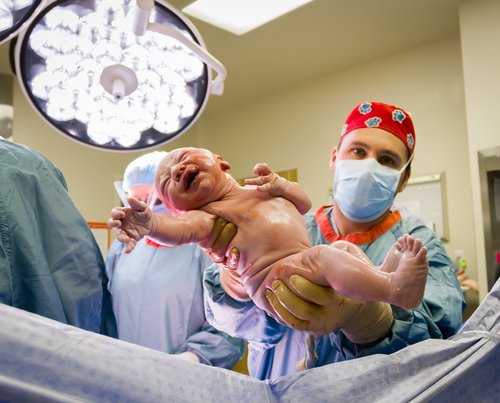Giving Birth: How Long Does Labor Last?

Your pregnancy is reaching its end, and it’s impossible not to be a little afraid of what’s to come: giving birth. One of the most common questions that women ask is: How long does labor last?
Today, we want to talk about just that.
There are three different stages that make up the physiological process of labor.
The duration from the beginning of labor until the actual delivery depends on various factors. These include the baby’s position, the mother’s emotional state, whether or not this is her first birth, etc.
“Quick” labors do exist. However, they are quite infrequent and usually bring complications for the mother and baby.
This type of birth is called “precipitous labor.” It is normally the result of complication or incidents during pregnancy.
It’s best for the birthing process to take as long as needed, without hurrying through any of the stages. That way, events will follow their normal course and the mother’s body will recover in the best way possible.
In order to have a real-time idea of how long labor can last, we invite you to read the following article.
We’ll discuss in detail the three stages that accompany your little one’s entry into this world.
How long does labor last? – the three stages
1. Dilation
This is the longest stage of labor and is divided into two phases. The first phase, called latent dilation, begins with contractions. These contractions help prepare the cervix.
The mother’s womb hardens and then relaxes without producing strong pain. Each contraction begins in the lower back and extends towards the belly and pelvis.
This stage has no defined time limit, since the contractions are irregular and can even last for days.
The following phase of dilation is active dilation. Active dilation begins when the cervix dilates to 3 or 4 centimeters.
The contractions become increasingly strong and regular, repeating every 3 to 5 minutes. At this point, a woman should go to the hospital.

2. Birth
This stage also consists of two phases. In the first, passive phase, the cervix has dilated enough for the baby’s head to pass through the birth canal. That is, 10 centimeters.
If the mother’s water hasn’t broken already, then this is the moment in which it will break. Contractions can occur one right after the other.
This phase lasts between 1 and 2 hours, depending on whether or not the woman has had children before. If so, this stage goes faster.
Then follows the active phase. The mother will now feel what is called the “pushing reflex.” Instinctively, she experiences the urge to push with each contraction – helping to bring her child to the outside world.
The baby’s head is visible in the birth canal. This phase can last between 35 and 50 minutes total.
However, if the woman has opted to receive an epidural, then this time can extend to 1 or 2 hours.
The medication suppresses the mother’s pushing reflex. Therefore, she must carry out the task consciously, following the instructions of her obstetrician.
“It’s best for the birthing process to take as long as needed, without hurrying through any of the stages”
3. Delivery of the placenta
This is the last stage of birth and takes place after the baby has already been born.
Painless contractions will cause the expulsion of the placenta, amniotic sac, and the membranes that contained the baby.
The cervix retracts and takes on a much smaller size. At the same time, the blood vessels that nourished the placenta slowly close.
The delivery of the placenta lasts approximately a half hour if the mother didn’t receive an epidural. With an epidural, this can take more than 60 minutes.
If you take into account the average times, childbirth can last a bit more than 9 hours in total. This duration refers to the beginning of the first stage of dilation to the final stage of delivering the placenta.

Of course, each woman is different and the exact duration of childbirth will vary depending on different factors. These factors include the mother’s age, physical condition, the number of previous births, and other factors as well.
Labor, like any process, has steps that need to take place one at a time so that the birth of your baby occurs without complications.
If you have any doubts, it’s best to consult a medical professional.
Your pregnancy is reaching its end, and it’s impossible not to be a little afraid of what’s to come: giving birth. One of the most common questions that women ask is: How long does labor last?
Today, we want to talk about just that.
There are three different stages that make up the physiological process of labor.
The duration from the beginning of labor until the actual delivery depends on various factors. These include the baby’s position, the mother’s emotional state, whether or not this is her first birth, etc.
“Quick” labors do exist. However, they are quite infrequent and usually bring complications for the mother and baby.
This type of birth is called “precipitous labor.” It is normally the result of complication or incidents during pregnancy.
It’s best for the birthing process to take as long as needed, without hurrying through any of the stages. That way, events will follow their normal course and the mother’s body will recover in the best way possible.
In order to have a real-time idea of how long labor can last, we invite you to read the following article.
We’ll discuss in detail the three stages that accompany your little one’s entry into this world.
How long does labor last? – the three stages
1. Dilation
This is the longest stage of labor and is divided into two phases. The first phase, called latent dilation, begins with contractions. These contractions help prepare the cervix.
The mother’s womb hardens and then relaxes without producing strong pain. Each contraction begins in the lower back and extends towards the belly and pelvis.
This stage has no defined time limit, since the contractions are irregular and can even last for days.
The following phase of dilation is active dilation. Active dilation begins when the cervix dilates to 3 or 4 centimeters.
The contractions become increasingly strong and regular, repeating every 3 to 5 minutes. At this point, a woman should go to the hospital.

2. Birth
This stage also consists of two phases. In the first, passive phase, the cervix has dilated enough for the baby’s head to pass through the birth canal. That is, 10 centimeters.
If the mother’s water hasn’t broken already, then this is the moment in which it will break. Contractions can occur one right after the other.
This phase lasts between 1 and 2 hours, depending on whether or not the woman has had children before. If so, this stage goes faster.
Then follows the active phase. The mother will now feel what is called the “pushing reflex.” Instinctively, she experiences the urge to push with each contraction – helping to bring her child to the outside world.
The baby’s head is visible in the birth canal. This phase can last between 35 and 50 minutes total.
However, if the woman has opted to receive an epidural, then this time can extend to 1 or 2 hours.
The medication suppresses the mother’s pushing reflex. Therefore, she must carry out the task consciously, following the instructions of her obstetrician.
“It’s best for the birthing process to take as long as needed, without hurrying through any of the stages”
3. Delivery of the placenta
This is the last stage of birth and takes place after the baby has already been born.
Painless contractions will cause the expulsion of the placenta, amniotic sac, and the membranes that contained the baby.
The cervix retracts and takes on a much smaller size. At the same time, the blood vessels that nourished the placenta slowly close.
The delivery of the placenta lasts approximately a half hour if the mother didn’t receive an epidural. With an epidural, this can take more than 60 minutes.
If you take into account the average times, childbirth can last a bit more than 9 hours in total. This duration refers to the beginning of the first stage of dilation to the final stage of delivering the placenta.

Of course, each woman is different and the exact duration of childbirth will vary depending on different factors. These factors include the mother’s age, physical condition, the number of previous births, and other factors as well.
Labor, like any process, has steps that need to take place one at a time so that the birth of your baby occurs without complications.
If you have any doubts, it’s best to consult a medical professional.
This text is provided for informational purposes only and does not replace consultation with a professional. If in doubt, consult your specialist.








